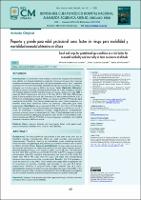| dc.contributor.author | Villamonte Calanche, Wilfredo | |
| dc.contributor.author | Escalante Guzmán, Darío | |
| dc.contributor.author | Jerí Palomino, María | |
| dc.date.accessioned | 2023-05-19T16:27:48Z | |
| dc.date.available | 2023-05-19T16:27:48Z | |
| dc.date.issued | 2022-03-31 | |
| dc.identifier.citation | Revista del Cuerpo Médico Hospital Nacional Almanzor Aguinaga Asenjo. 2022:15(1). | es_PE |
| dc.identifier.issn | 2227-4731 | |
| dc.identifier.uri | https://hdl.handle.net/20.500.12959/3698 | |
| dc.description.abstract | Introducción: El crecimiento fetal en altura es menor en comparación al nivel del mar, debido a la hipoxia hipobárica existente. Consecuentemente hay menores medidas antropométricas neonatales. No hay información acerca de la capacidad de predicción de morbimortalidad neonatal usando los criterios de Lubchenco y Battaglia con la tabla creada a 3400 m de altura (TANA). Material y Métodos: Estudio de casos y controles. Usamos la información de 16 000 neonatos a término del Hospital Nacional Adolfo Guevara Velazco en Cusco, desde enero del 2003 a junio del 2012. Evaluamos el percentil 3, 10, 90 y 97 (P3, P10, P90 y P97) de los pesos e índice ponderal al nacer (IP). Neonatos con antropometría menor al P3 y P10 fueron considerados pequeños (PEG) y los mayores al P90 y P97 grandes para edad gestacional (GEG). Estos fueron considerados los casos, mientras aquellos con medidas entre estos intervalos fueron los controles (adecuados para edad gestacional). Resultados: La prevalencia de PEG (P10) fue 9,6% y 10,7% de GEG (P90). El P3 del peso al nacer (PN) incrementa el riesgo de ocurrencia en 3,2 y 10,7 veces de morbilidad y mortalidad neonatal, respectivamente. Similarmente, pronostica la mayor estancia hospitalaria (6,2 días). Conclusiones: Aplicando los criterios de Lubchenco y Battaglia, así como P3 y P97 del PN e IP utilizando la TANA, determinamos que el P3 del PN define el mayor riesgo para morbilidad y mortalidad neonatal a término a 3400 m de altura. | es_PE |
| dc.description.abstract | Background: The fetus growth at high altitude is less than at sea level due to
hypobaric hypoxia. Consequently, there are small neonatal anthropometric
measurements. Therefore, there is no information about predicting neonatal
morbi-mortality using Battaglia and Lubchenco criteria by neonatal curve created
at 3400-m altitude (TANA). Material and Methods: It was a case-control study.
We used the information of 16000 term infants from the Adolfo Guevara Velazco
National Hospital in Cusco, from January 1, 2003, to June 30, 2012. We evaluated
the 3rd, 10th, 90th, and 97th percentile (P3, P10, P90, and P97) of newborns weight
and ponderal index (PI). Neonatal anthropometry less than P3 or P10 (SGA) and
higher than P90 or P97 (LGA) were the cases, and those with measurements
between these intervals were the controls (AGA). Results: SGA (P10) prevalence
was 9.6% and 10.7% of LGA (P90). The P3 of the birth weight (BW) increases the risk
of occurrence of neonatal morbidity and mortality in 3.2 and 10.7 times,
respectively. Similarly, it prognosticates longer hospital stay (6.2 days).
Conclusions: Applying the Lubchenco and Battaglia criteria and P3 and P97 of the
BW and PI using the TANA, we determined that the P3 of the BW defines the highest
risk for neonatal morbidity and mortality at term newborns at 3400-m altitude. | es_PE |
| dc.format | application/pdf | es_PE |
| dc.language.iso | spa | es_PE |
| dc.publisher | Seguro Social de Salud (EsSalud) | es_PE |
| dc.relation.uri | http://cmhnaaa.org.pe/ojs/index.php/rcmhnaaa/article/view/1083 | es_PE |
| dc.rights | info:eu-repo/semantics/openAccess | es_PE |
| dc.rights.uri | https://creativecommons.org/licenses/by-nc-sa/4.0/ | es_PE |
| dc.subject | Hipoxia | es_PE |
| dc.subject | Retardo del crecimiento fetal | es_PE |
| dc.subject | Edad gestacional | es_PE |
| dc.subject | Altura | es_PE |
| dc.subject | Mortalidad neonatal | es_PE |
| dc.subject | Perú | es_PE |
| dc.subject | Hypoxia | es_PE |
| dc.subject | Fetal growth restriction | es_PE |
| dc.subject | Gestational age | es_PE |
| dc.subject | Altitude | es_PE |
| dc.subject | Neonatal mortality | es_PE |
| dc.title | Pequeño y grande para edad gestacional como factor de riesgo para morbilidad y mortalidad neonatal a término en altura | es_PE |
| dc.title.alternative | Small and large for gestational age condition as a risk factor for neonatal morbidity and mortality at term newborns at altitude | es_PE |
| dc.type | info:eu-repo/semantics/article | es_PE |
| dc.subject.ocde | https://purl.org/pe-repo/ocde/ford#3.02.02 | es_PE |
| dc.identifier.doi | https://doi.org/10.35434/rcmhnaaa.2022.151.1083 | |






